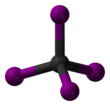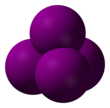Carbon tetraiodide

| |||
| |||
| Names | |||
|---|---|---|---|
| IUPAC names
Tetraiodomethane
Carbon tetraiodide | |||
| Other names
Carbon iodide
| |||
| Identifiers | |||
3D model (JSmol)
|
|||
| ChemSpider | |||
| ECHA InfoCard | 100.007.335 | ||
| EC Number |
| ||
PubChem CID
|
|||
| RTECS number |
| ||
CompTox Dashboard (EPA)
|
|||
| |||
| |||
| Properties | |||
| CI4 | |||
| Molar mass | 519.6286 g/mol | ||
| Appearance | red crystals | ||
| Density | 4.32 g/cm3 | ||
| Melting point | 171 °C (444 K) decomp. | ||
| Insoluble | |||
| Structure | |||
| Monoclinic | |||
| Tetrahedral | |||
Except where otherwise noted, data are given for materials in their standard state (at 25 °C [77 °F], 100 kPa).
| |||
Carbon tetraiodide is CI4, a tetrahalomethane. Being bright red, it is a relatively rare example of a highly colored methane derivative. It is only 2% by weight carbon, although other methane derivatives are known with still less carbon.
The tetrahedral molecule features C-I distances of 2.12 ± 0.02 Å. [1] The molecule is slightly crowded with short I---I contacts of 3.459 ± 0.03 Å, and possibly for this reason, it is thermally and photochemically unstable. Hexaiodoethane is unknown, probably for the same reason.
Carbon tetraiodide crystallizes in monoclinic crystal structure (a 22.39, b 12.93, c 25.85 (.10-1 nm), β 125.26°).
It has dipole moment of 0 Debyes due to its symmetrically substituted tetrahedral molecule.
Properties, synthesis, uses
CI4 is slightly reactive towards water, giving iodoform and I2. Otherwise it is soluble in nonpolar organic solvents. It decomposes thermally and photochemically to tetraiodoethylene, I2C=CI2. Its synthesis entails AlCl3-catalyzed halide exchange, which is conducted at room temperature:[2]
- CCl4 + 4 EtI → CI4 + 4 EtCl
The product crystallizes from the reaction solution.
CI4 is used as an iodination reagent, often upon reaction with base. [3] Ketones are converted to 1,1-diiodoethenes upon treatment with PPh3 and CI4. Alcohols are converted in and to iodide, by a mechanism similar to the Appel reaction. In an Appel reaction carbon tetrachloride is used to generate the chloride from alcohols.
Safety considerations
Manufacturers recommend that CI4 be stored near 0 °C. As a ready source of iodine, it is an irritant. LD50: 178 mg.kg–1. In general perhalogenated organic compounds should be considered toxic.
References
- ^ Finbak, Chr.; Hassel, O. "Kristallstruktur und Molekülbau von CI4 und CBr4" Zeitschrift für Physikalische Chemie (1937), volume B36, page 301-8
- ^ McArthur, R. E.; Simons, J. H., “Carbon Tetraiodide” Inorganic Syntheses 1950, volume III, 37–39
- ^ P. R. Schreiner, A. A. Fokin, “Carbon Tetraiodide” in Encyclopedia of Reagents for Organic Synthesis (Ed: L. Paquette) 2005; John Wiley & Sons, Ltd
Further reading
Sorros, H., Hinkam J. B. , “The Redistribution Reaction. XI. Application to the Preparation of Carbon Tetraiodide and Related Halides” Journal of the American Chemical Society 1945, 67, 1643. DOI.


